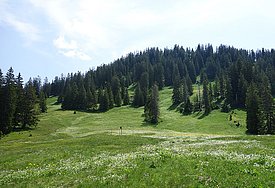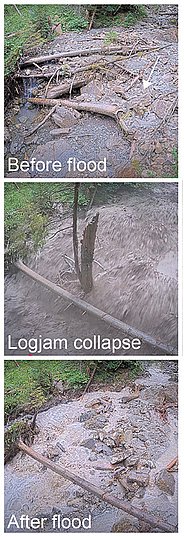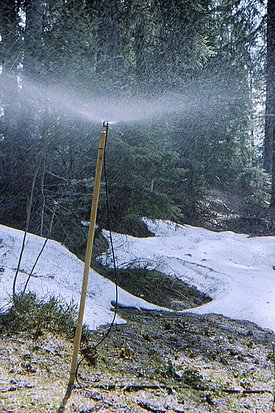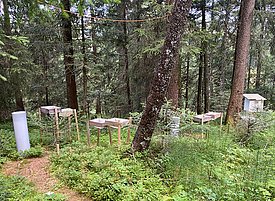
Current research activities ¶
Contents ¶
Runoff generation mechanisms ¶

Field studies in one of the sub-catchments, Studibach, focus on understanding runoff generation mechanisms (i.e., how rainfall and snowmelt become streamflow) in steep mountain catchments underlain by low permeability soils. After extensive studies on groundwater levels and groundwater chemistry, current work focuses on near surface flow pathways: overland flow and subsurface flow through the organic rich topsoil layer. This work (2021-2024) involves the installation of runoff plots, stream monitoring, tracer experiments, and rainfall simulation experiments.
Contact: Anna Leuteritz, Victor Gauthier, Dr. Ilja van Meerveld (Uni Zurich)
Sediment and wood transport ¶

Floods in steep mountain catchments mobilize large amounts of sediment and wood. These materials strongly influence channel morphology, aquatic habitats, and the functioning of hydraulic infrastructures. At the Erlenbach, we investigate how sediment and wood are transported and deposited during different flow conditions, from low flows to floods. Our research combines long-term monitoring data from Swiss Plate Geophones with field experiments such as colored sediment tracers, grain size analyses, time-lapse cameras, and drone surveys. These methods help reconstruct floods in detail (e.g. flood in July 2024), identify transport thresholds, and assess long-term changes in sediment and wood dynamics under climate change. The results provide valuable insights for hazard mitigation and river management in steep alpine catchments.
Contact: Isabella Schalko, Felix Blumenschein (WSL)
Nitrogen dynamics Alptal ¶

Nitrogen deposition is a potential threat for forests as it can affect the equilibrium between plant nutrients and disturb the botanical composition of the herb layer. Too much nitrogen can also lead to nitrate leaching into surface waters. In a long-term experiment in a very small headwater catchment, we add ammonium nitrate to rain water sprinkled over the ground vegetation. We study the fate of this added nitrogen and its effects on soil (including greenhouse gas exchanges), plants and water. Results so far show an accumulation of nitrogen in the soil, but with relatively small effects on plants in general and a slight improvement of tree growth in particular. Nitrate leaching from the treated catchment increased compared to a control catchment. This was especially the case when part of the trees were cut because production by mineralisation in the soil plus deposition then clearly exceeded plant demand for nitrogen.
Kontakt: Patrick Schleppi (WSL)
In what concentrations are forever chemicals (PFAS) found here? ¶

Per- and polyfluoroalkyl substances (PFAS) are a class of synthetic chemicals widely used for their water- and grease-repellent properties in industrial and consumer products. While their persistence and mobility in aquatic systems are increasingly well documented, their fate in forested catchments remains poorly understood. In the remote Alptal catchment and on the Hönggerberg just north of Zurich (“Waldlabor”), we measure 43 different types of PFAS —including trifluoroacetic acid (TFA)—in precipitation, throughfall, litterfall, and runoff to quantify inputs to and outputs from the catchments. Ongoing work includes sampling soil and soil water to assess which compounds accumulate or are mobilized within the terrestrial system. By linking atmospheric deposition to hydrological export, this study sheds light on PFAS transport through a subalpine spruce forest and a temperate mixed forest dominated by beech and spruce trees. These initial data will help establish a basis for future environmental monitoring and chemical regulation.
Contact: Stefan Osterwalder (Uni Zürich/ETHZ)
What do eDNA traces tell us about biodiversity in these catchments? ¶
Text ca. 800-900 Zeichen (inkl. Leerzeichen)
Contact: Camille Albouy, Sarah Thurnheer , Loïc Pellissier
